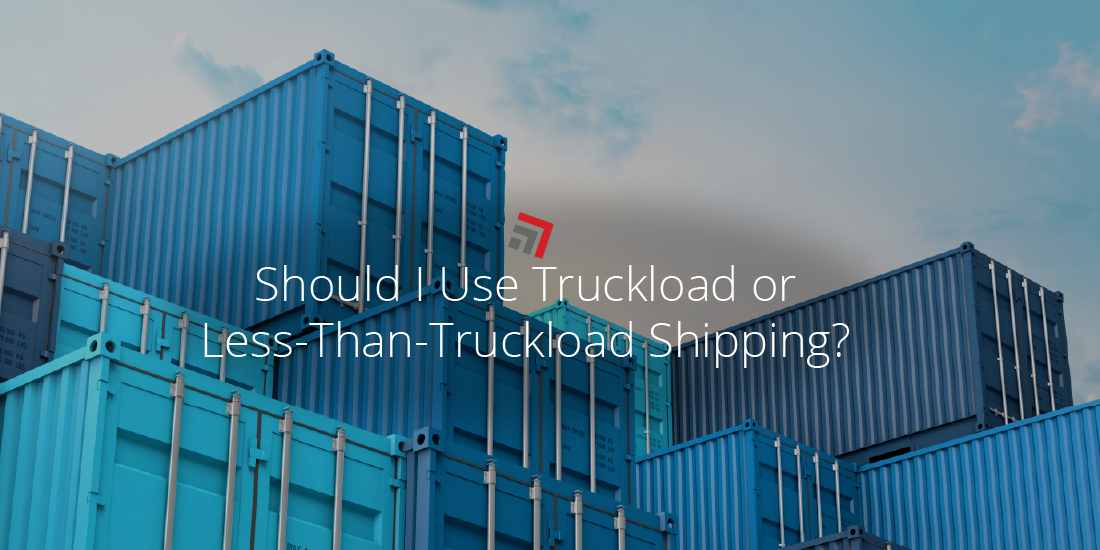It can be difficult to decide between Truckload and Less-Than-Truckload shipping. Unless your company is shipping a lot of cargo, whereby the choice to ship full truckload may be a relatively simple decision, sitting right on the tipping point between either can bring a lot of questions into the mix.
Everything from cargo type, dimensions (width, height, and length), freight classification, and weight can all contribute to different shipping pricing, and each of these factors will weigh in differently of freight costs if you ship LTL vs. truckload (or vice versa). So, if you’re struggling to decide which mode of shipping is right for your company, here are a few general guidelines:
Truckload vs. Less-Than-Truckload Shipping: Which to Use?
There is no clear-cut “line” at which cargo should switch over from being LTL to full truckload freight. So, with that in mind, the best way for us to offer a suggestion is to lay out some simple definitions, guidelines, and benefits of each mode of shipping and allow you to make the decision based on that information! Here is a high-level overview of each type of shipping, as well as respective pros/cons of each:
Less-Than-Truckload Shipping
LTL shipping, otherwise known as Less-Than-Truckload, is a mode of shipping by which your freight is consolidated with the freight of other shippers in a single shipping container. Here are some of the primary benefits of LTL Shipping:
Benefits of Less-Than-Truckload Shipping
1) Smaller Shipments
The most obvious benefit of LTL shipping is that it makes it simpler to ship smaller loads of cargo. If your business ships cargo rather infrequently, or each shipment is relatively small (only a few pallets or less at a time), LTL poses a huge advantage over full truckload freight.
2) Multiple Destinations
Another huge advantage of Less-Than-Truckload shipping is that it is often more efficient for shipping to end customers in multiple locations. If your business frequently ships small loads of cargo to end customers all around the U.S., LTL shipping may be a quicker and cheaper solution.
3) Technology & Visibility
The LTL industry has, for the most part, some of the most up-to-date technology when it comes to shipping. Everything including quoting and estimates, pickup confirmation, tracking, and invoicing can all be automated or easily managed through accessible, intuitive online tools provided through your carrier.
Full Truckload Shipping
Full truckload shipping is a shipping mode that involves renting an entire trailer to ship your cargo. Full truckload shipping has a multitude of benefits over LTL, but the benefits must be weighed with the costs. Here is an overview of some of the advantages of full truckload shipping:
Benefits of Full Truckload Shipping
1) Lower Risk
The risk of cargo damage during transit with LTL shipments is rather high. Since your cargo is being consolidated and deconsolidated with multiple other shippers’ cargo throughout the shipping process, it’s fingerprinted significantly more and thus is more prone to damage.
Fortunately, with full truckload shipping, your cargo isn’t unloaded, transferred, and reloaded onto additional carriers’ trailers. You rent it, load it, and ship it. Risk of damage is minimal, and in the off chance your cargo is damaged, it’s easy to locate and hold the responsible party accountable for the damage. Of course, it’s always a good idea to just insure your cargo.
2) Speed
Your cargo is moving straight from its origin and straight to its destination. No unnecessary stops and deconsolidation points. No unnecessary sitting around. It’s streamlined and fast. You and your carrier can work together to figure out ideal delivery dates and stick to them without the interference of 3rd parties.
3) Shipment Size
The biggest benefit of truckload shipping is shipment size. Since truckload shipping involves renting the full trainer, you have a ton of room to work with. You shouldn’t need to worry about having enough size as long as your cargo dimensions fit inside a standard semi-trailer (make sure to research the dimensions of the trailer you plan on loading your cargo onto.)
Which Should I Pick? LTL vs. Full Truckload
As states before, there’s no “rule” regarding which to select. However, a good rule of thumb is the two-thirds rule. If your cargo is going to fill up two-thirds of a semi-trailer, chances are it will be significantly more cost effective to rent the entire trailer and ship it as full-truckload.
Even if your cargo doesn’t fill more than half of a semi-trailer, it may be worth it to consider the cost savings of doing less LTL shipments and instead shipping less-frequent, larger full truckload shipments. This type of consolidation can save shippers tons of money, but we also understand it’s extra work put into planning and preparation.
If your business is looking for ways to save money, time, risk, and resources when shipping domestic cargo, reach out to one of our team members and ask us for recommendations! We’re well versed in all things LTL and truckload and would be happy to start a conversation with you regarding which shipping mode is best for you!



Recent Comments